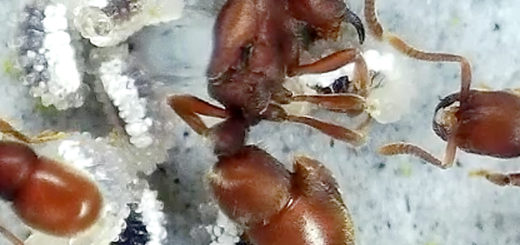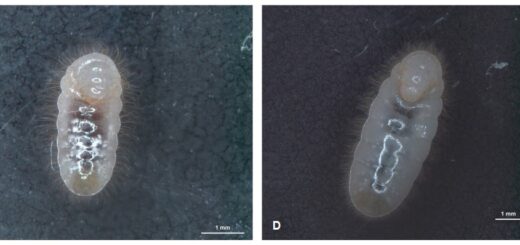Tetramorium aspina, a possible social parasite of Tetramorium immigrans
In the recently published article “A mixed colony of Tetramorium immigrans Santschi, 1927 and the putative social parasite Tetramorium aspina sp.n. (Hymenoptera: Formicidae)”, Herbert Wagner, Celal Karaman, Volkan Aksoy, and Kadri Kiran combine the taxonomic description of their new species with details on what they conclude to be a socially parasitic life history. Here, Sarah Bengston highlights their main points.
A Review compiled by Sarah Bengston

Interactions between species are strong drivers of evolutionary change. The co-evolutionary forces between predators and prey, parasites and hosts, or mutually benefiting symbionts, for example, can drive complex morphological, physiological, and/or behavioral trait evolution and diversification.
There is a stunning diversity in the co-evolutionary interactions between host species and their associated parasites. These can range from disease inducing microorganisms to avian brood parasitism (Yazdanbakhsh & al. 2002; Lyon & Eadie 2008). One unique form of parasitism is social parasitism in the eusocial Hymenoptera. Social parasites usurp social insect colonies to realize their own fitness (Bourke & Franks 1991). Social parasitism is widely varied in expression and evolved independently many times. Generally speaking, we can classify these interactions as guest parasitism, temporary social parasitism, dulosis, or
Despite numerous well-described host/social-parasite relationships, the factors leading to the evolutionary origin of social parasitism remain unresolved. For example, the “Emery’s Rule” hypothesis, which posits that social parasite species are closely related to their host species has gone through several iterations, including strict vs. loose, which determines how closely related the species must be or if the species must be closely related at all (Ward 1989, 1996; Rabeling & al. 2014). This observation has led to the hypothesis that some social parasites evolved from their host species after achieving reproductive isolation in sympatry (Buschinger 1990; Bourke &Franks 1991; Rabeling & al. 2014). The evolution of dulosis has been hypothesized to derive from several facultative behaviors, including brood robbing after a territorial contest or as a byproduct of brood predation (Hölldobler 1979; Buschinger 1986, 2009).
Increasing the number of natural replicates is important to solve the remaining questions about the evolutionary origins of social parasitism, which hold significant relevance for understanding speciation, social evolution, and evolutionary convergence. This can not only improve our phylogenetic resolution of social parasite evolution but also bolster our knowledge of what ecological conditions favor the emergence of different socially parasitic life histories.
One article doing just that is the recently published “A mixed colony of Tetramorium immigrans Santschi, 1927 and the putative social parasite Tetramorium aspina sp.n. (Hymenoptera: Formicidae)” by Herbert C. Wagner, Celal Karaman, Volkan Aksoy, and Kadri Kiran. In this excellent natural history observation, the authors describe a previously unknown species of Tetramorium found in the East Black Sea Region of Turkey. The authors note this area has received little previous attention from myrmecologists, making it an exciting area of exploration. During their survey, they discovered a mixed colony comprising T. immigrans workers and a similar number of T. aspina sp.n. workers. While no T. immigrans queen was found, there was a T. aspina sp.n queen. While there were a variety of brood items, most were larvae that could not be identified. One pupa was present, which was identified as T. aspina sp. n.. Tetramorium aspina sp. n. was not a cryptic species, but instead had distinct morphological differences making it easily distinguished from T. immigrans in the field.

These initial findings support the authors’ interpretation that this is probably a new example of social parasitism. The observations are consistent with (a) dulosis, where workers of the queenright species raid neighboring colonies and steal their brood, or (b) temporary social parasitism, where the parasite queen invades the host colony, kills the resident queen, and usurps the worker force to raise her offspring. While inquilinism cannot be entirely ruled out, it is not as likely of an explanation because most inquiline species are host-queen tolerant (and no T. immigrans queen was located), and the majority of inquiline species do not produce a worker caste.
In general, this article is of interest because it describes another potential socially parasitic species and resultant host species. It provides another example of an evolutionary transition to social parasitism which opens a significant line of inquiry about what type of social parasitism this is and how it evolved. Additionally, it further emphasizes the value of continuing rigorous exploration of lesser explored areas and the value of natural history observations. While this remains an area that is plagued by challenges associated with funding, observations such as this emphasize that discoveries are still out there, if we only look.

References
Bourke, A.F.G., & N.R. Franks. 1991: Alternative adaptations, sympatric speciation and the evolution of parasitic, inquiline ants. – Biological Journal of the Linnean Society 43: 157-178.
Buschinger, A. 1986: Evolution of social parasitism in ants. – Trends in Ecology & Evolution 1: 155-160.
Buschinger, A. 1990: Sympatric speciation and radiative evolution of socially parasitic ants – Heretic hypotheses and their factual background. – Journal of Zoological Systematics and Evolutionary Research 28: 241-260.
Buschinger, A. 2009: Social parasitism among ants: a review (Hymenoptera: Formicidae). – Myrmecological News 12: 219-235.
Hölldobler, B. 1979: Territoriality in Ants. – Proceedings of the American Philosophical Society 123: 211-218.
Hölldobler, B., & E.O. Wilson. 1990: The Ants. – Harvard University Press, 746 pp.
Huang, M.H., & A. Dornhaus. 2008: A meta-analysis of ant social parasitism: host characteristics of different parasitism types and a test of Emery’s rule. – Ecological Entomology 33: 589-596.
Lyon, B.E., & J.M. Eadie. 2008:Conspecific Brood Parasitism in Birds: A Life-History Perspective. – Annual Review of Ecology, Evolution, and Systematics 39: 343-363.
Rabeling, C., T.R. Schultz, N.E. Pierce, & M. Bacci Jr. 2014: A Social Parasite Evolved Reproductive Isolation from Its Fungus-Growing Ant Host in Sympatry. – Current Biology 24: 2047-2052.
Ward, P. 1989: Genetic and social changes associated with ant speciation. The Genetics of Social Evolution. – Westview Press, Boulder, Colorado, 462 pp..
Ward, S. 1996: A new workerless social parasite in the ant genus Pseudomyrmex (Hymenoptera: Formicidae), with a discussion of the origin of social parasitism in ants. – Systematic Entomology 21: 253-263.
Yazdanbakhsh, M., P.G. Kremsner, & R. van Ree. 2002: Allergy, Parasites, and the Hygiene Hypothesis. – Science 296: 490-494.





And the conditions in which social parasitism evolves.
Great to see u!!
A very, very beautifull ant species!